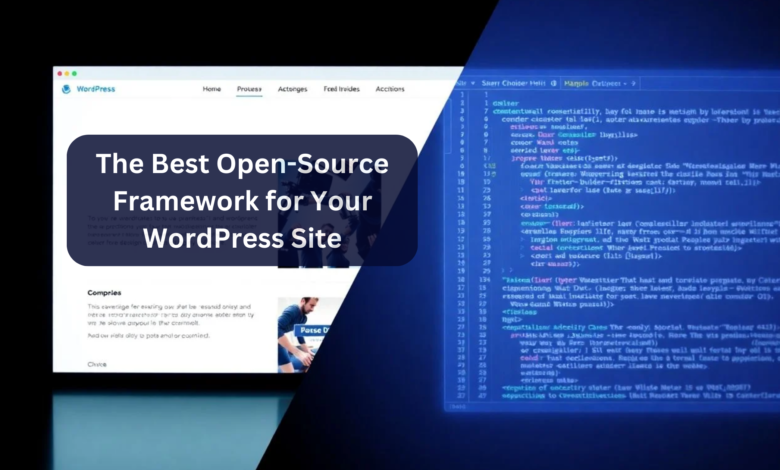The Best Open-Source Framework for WordPress Site 2025
Understanding Popular Open-Source Frameworks

WordPress powers over 40% of all websites globally. With this immense market share, choosing the right framework for development becomes crucial. Open-source Framework for WordPress provide cost-effective solutions, flexibility for customization, and a supportive community for developers. This article explores popular open-source frameworks for WordPress: React, Vue.js, and Angular, helping you decide which fits best for your project.
React: Overview, Strengths, and Weaknesses
React is a JavaScript library focused on building user interfaces. It’s known for its component-based architecture, allowing developers to create reusable UI components.
Strengths:
- Fast rendering through Virtual DOM.
- Strong community support and ecosystem.
- Reusable components reduce development time.
Weaknesses:
- Can become complex with larger applications.
- Requires understanding of Javascript ES6+.
Real-World Examples:
- Facebook uses React for its front-end.
- The New York Times incorporates React for its dynamic content.
Vue.js: Overview, Strengths, and Weaknesses
Vue.js is another progressive JavaScript framework that is approachable and versatile. It’s ideal for creating single-page applications.
Strengths:
- Lightweight and easy to integrate.
- Reactive two-way data binding.
- Detailed documentation and active community.
Weaknesses:
- Smaller community compared to React.
- Limited resources for larger applications.
Real-World Examples:
- Alibaba utilizes Vue.js for a seamless shopping experience.
- Xiaomi’s website benefits from Vue.js’s responsiveness.
Angular: Overview, Strengths, and Weaknesses
Angular is a platform for building mobile and desktop web applications. It is developed and maintained by Google.
Strengths:
- Comprehensive framework with strong punch.
- Built-in tools for routing and state management.
- Typescript support enhances reliability.
Weaknesses:
- The steeper learning curve for beginners.
- It can be too heavy for smaller projects.
Real-World Examples:
- Google Cloud Platform uses Angular for its web applications.
- Upwork employs Angular for its seamless user experience.
Framework Comparison: Key Features and Considerations
Performance Benchmarks: A Comparative Analysis
Performance plays a crucial role in user experience and SEO. According to recent studies:
- React can render updates up to 30% faster than traditional frameworks.
- Vue.js provides quick load times with minimal overhead.
- Angular requires more resources, making it slower on initial loads.
Choosing the right framework impacts not only page speed but also search engine rankings. Quick-load sites often rank better in search results.
Scalability and Maintainability: Long-Term Growth
- React excels in scalability, particularly for applications expecting to grow.
- Vue.js is best suited for small to medium projects, where rapid iteration is vital.
- Angular supports large enterprise applications, providing robust tools for long-term maintenance.
Community Support and Resources: Access to Help
- React has a substantial community, fostering numerous libraries and resources.
- Vue.js is growing rapidly, with a supportive and engaging community.
- Angular has extensive documentation and resources backed by Google.
Why Choosing the Right Framework for WordPress is Essential for Your Project Needs
Selecting the right framework is one of the most critical decisions when starting any project, whether it’s web development, app design, or even creating a custom workflow. Here’s why making the right choice matters and how it can impact your project success.
1. Efficiency and Productivity
The right framework provides pre-built tools, libraries, and templates that streamline development. It reduces repetitive tasks, allowing you to focus on solving complex problems. For instance:
- Web frameworks like Laravel or Django speed up backend development.
- Front-end frameworks like React or Vue.js help build dynamic, responsive user interfaces.
Choosing the wrong framework may lead to unnecessary delays and require extra resources to accomplish simple tasks.
2. Scalability for Future Growth
Your project framework should align with long-term goals. A scalable framework allows your project to grow seamlessly with increased users, features, or data.
For example:
- Enterprise projects might need robust frameworks like Spring Boot for scalability.
- Smaller applications can benefit from lightweight frameworks like Flask or Express.
Ignoring scalability can result in performance issues and costly migrations later.
3. Compatibility with Your Project Needs
Every framework has strengths and weaknesses. Matching your project requirements with the framework’s features ensures compatibility:
- Does it support your preferred programming language?
- Is it suitable for your industry (e.g., e-commerce, blogging, SaaS)?
For example, WordPress is excellent for blogging or small business websites, while frameworks like Angular are ideal for complex web applications.
4. Community Support and Resources
A well-supported framework has an active community, abundant tutorials, and frequent updates. This is invaluable for troubleshooting and staying up-to-date with the latest practices.
Frameworks like Node.js or Ruby on Rails benefit from vibrant developer communities, while lesser-known frameworks may lack such resources.
5. Cost and Learning Curve
Consider the time and cost required to master a framework. If the learning curve is steep, your team might struggle to deliver on time. Opt for a framework that matches your team’s skill set and experience to avoid unnecessary expenses.
Choosing the right framework is more than a technical decision—it’s a strategic move that determines your project’s efficiency, growth, and sustainability. Take the time to evaluate your needs, team expertise, and project goals to ensure you pick a framework that propels your project forward.
How Framework Alignment for Your Next Project
Project Size and Complexity: Framework Alignment
Evaluate your project’s scale:
- Small Projects: Vue.js or React might be ideal.
- Medium Projects: Consider React for flexibility or Angular for robustness.
- Large Projects: Angular is well-suited for complex applications with many moving parts.
Developer Expertise and Team Skillsets: Practical Considerations
Assess your team’s skills:
- If your team knows JavaScript well, React or Angular may work best.
- If there’s less experience, Vue.js offers simplicity and a gentler learning curve.
Budget and Time Constraints: Realistic Expectations
Factor in your budget:
- React and Vue.js typically demand less initial investment in training.
- Angular may require more expertise, potentially increasing costs.
Security Considerations for Each Framework
Each framework presents unique security considerations:
- React: Regular updates are vital to address vulnerabilities.
- Vue.js: Ensure only trusted plugins are used to avoid issues.
- Angular: Built-in security features enhance protection against XSS attacks.
Actionable Tips:
- Conduct regular security audits.
- Stay updated on framework versions.
Regular Updates and Maintenance: Long-Term Security
Keeping frameworks up-to-date protects against potential exploits. Plan for regular maintenance cycles and monitor updates.
Integration with WordPress: Seamless Compatibility
All three frameworks integrate well with WordPress. Ensure compatibility with essential plugins and WordPress free themes. This enhances user experience and functionality.
Conclusion
When choosing an open-source framework for WordPress, consider key features, scalability, performance, and security. Each framework has unique traits suited for different project needs.
Reflect on your project size, complexity, and team skills. Setting realistic timelines and budgets will also guide your choice. Start your project with the right framework, aligning technology with your goals for optimal results.
Explore your options today! Choose the framework that best fits your vision and get started on building a powerful WordPress site.



